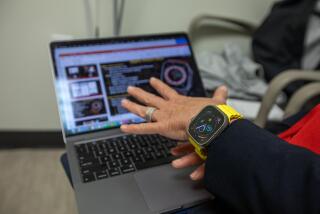Outside World Can Be a Click Away for Patients
- Share via
HOUSTON — For someone who was hospitalized at 4 a.m., Rita Wright was surprisingly upbeat.
A day after being admitted with a painful bowel obstruction, Wright was expecting a lonely stay in a sterile hospital room. But to her relief, she was greeted by a surprise at Memorial Hermann Memorial City Hospital: a computer screen above her bed that allowed her to keep in touch with family, friends and work via the Internet.
“You can do a lot of stuff in the hospital while you’re waiting. I just love it,” said Wright, 58, a real estate agent.
The hospital is among the few nationwide using Pyxis PatientStation, a personal computer with a virtual keyboard that allows patients to go online, check e-mail, watch television, listen to the radio and play games. Officials believe the device’s potential includes improving patient care, automated record keeping and dispensing medications.
The system consists of a 15-inch flat touch screen attached to a movable metallic arm mounted to the floor. Patients touch the screen to tune in local TV channels, learn about the hospital or watch relaxation videos. They can access cable channels, high-speed Internet service, radio stations and 20 games. Memorial City charges $9.95 a day for the service for the first 10 days, then it’s free. Rates vary with each city.
The PatientStation, made by San Diego-based Pyxis Corp., has a small digital camera mounted on top. The company hopes to incorporate technology allowing people to instantly e-mail pictures of newborn babies and allow doctors to record video messages for patients.
Detroit Medical Center was the first to use it in late 2002. Henry Mayo Newhall Memorial Hospital in Valencia and the Morristown-Hamblen Healthcare System in Morristown, Tenn., also have installed PatientStation. Twenty-four hospitals nationwide have signed up and about 1,000 units are in use.
At the Houston hospital, 121 beds have the PatientStation. The entire Memorial Hermann Hospital system is planning to use it within 18 months.
Wayne Voss, CEO at Memorial City, said one patient told him that he was able to forget about his pain by playing some of the system’s games.
“Instead of giving him a narcotic, give him some entertainment, get [his] mind off of it,” he said. “It’s a high-touch, high-tech way to bring the whole patient stay to a different level.”
Stephen Spann, chairman of the department of family and community medicine at Baylor College of Medicine, recounted his talk with a patient getting chemotherapy. “He was telling me how bored he was and getting online was difficult,” Spann said. “Getting access to [a] personal computer, the Web, e-mail will be a real plus.”
Fran Davis, a nurse at Memorial City, said she’s looking forward to what the device will mean in the future. Doctors and nurses may soon be able to access patient records in the room, saving time and paperwork. But Davis is even more excited at the prospect that the system could one day be incorporated with a secured small cabinet to dispense medicine.
Davis said the technology’s potential will mean more human contact between patients and healthcare providers because more work will take place inside the room. She believes that it will be a good education tool too.
For patients, though, the PatientStation is all about staying in touch with the rest of the world.
Wright said she was once in a hospital for 11 days without Internet access.
“I was isolated from the things that are really so much a part of my life: my job and my family,” she said. “When you get e-mails from people, it makes you feel better. It keeps your spirits up. I’m happy.”






